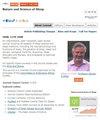基于加速度测量、皮肤温度和上下文信息预测睡眠和觉醒的机器学习模型
IF 3.4
2区 医学
Q2 CLINICAL NEUROLOGY
引用次数: 0
摘要
目的:在基于人群的研究中,体戴式加速度计通常用于估算睡眠时间。然而,由于基于加速度计的睡眠/觉醒评分依赖于检测身体运动,因此预测睡眠持续时间仍然是一项挑战。研究的目的是开发和评估机器学习(ML)模型的性能,以预测基于加速度计的睡眠持续时间,并探讨是否可以通过在模型中添加皮肤温度数据、基于睡眠中点估计的昼夜节律和周期性时间特征来改善预测效果:29 名成年人(17 名女性)参加了研究,平均(标清)年龄为 40.2(15.0)岁(17-70 岁不等)。研究人员在睡眠实验室或家中记录了一夜的多导睡眠图(PSG),并通过两个加速度计记录了身体运动情况,加速度计内嵌皮肤温度传感器(AX3,Axivity,英国),分别位于腰部和大腿处。睡眠/觉醒的 PSG 评分被用作训练 ML 模型的基本事实:结果:根据输入到 ML 模型的纯加速度计数据,预测睡眠/觉醒的特异性和灵敏度分别为 0.52(SD 0.24)和 0.95(SD 0.03)。将皮肤温度数据和上下文信息添加到 ML 模型后,特异性提高到 0.72(标准差 0.20),而灵敏度则保持不变,仍为 0.95(标准差 0.05)。相应地,睡眠高估时间从 54 分钟(228 分钟,协议范围极限 [LoAR])减少到 19 分钟(154 分钟,协议范围极限 [LoAR]):结论:在双加速度计设置的基础上,当模型中加入皮肤温度数据和上下文信息时,ML 模型能以极高的灵敏度和适度的特异性预测睡眠/觉醒时间。 关键词:动图;流行病学;久坐行为;睡眠质量;监督机器学习;支持向量机本文章由计算机程序翻译,如有差异,请以英文原文为准。
A Machine Learning Model for Predicting Sleep and Wakefulness Based on Accelerometry, Skin Temperature and Contextual Information
Purpose: Body-worn accelerometers are commonly used to estimate sleep duration in population-based studies. However, since accelerometry-based sleep/wake-scoring relies on detecting body movements, the prediction of sleep duration remains a challenge. The aim was to develop and evaluate the performance of a machine learning (ML) model to predict accelerometry-based sleep duration and to explore if this prediction can be improved by adding skin temperature data, circadian rhythm based on the estimated midpoint of sleep, and cyclic time features to the model.
Patients and Methods: Twenty-nine adults (17 females), mean (SD) age 40.2 (15.0) years (range 17– 70) participated in the study. Overnight polysomnography (PSG) was recorded in a sleep laboratory or at home along with body movement by two accelerometers with an embedded skin temperature sensor (AX3, Axivity, UK) positioned at the low back and thigh. The PSG scoring of sleep/wake was used as ground truth for training the ML model.
Results: Based on pure accelerometer data input to the ML model, the specificity and sensitivity for predicting sleep/wake was 0.52 (SD 0.24) and 0.95 (SD 0.03), respectively. Adding skin temperature data and contextual information to the ML model improved the specificity to 0.72 (SD 0.20), while sensitivity remained unchanged at 0.95 (SD 0.05). Correspondingly, sleep overestimation was reduced from 54 min (228 min, limits of agreement range [LoAR]) to 19 min (154 min LoAR).
Conclusion: An ML model can predict sleep/wake periods with excellent sensitivity and moderate specificity based on a dual-accelerometer set-up when adding skin temperature data and contextual information to the model.
Keywords: actigraphy, epidemiology, sedentary behaviors, sleep quality, supervised machine learning, support vector machines
Patients and Methods: Twenty-nine adults (17 females), mean (SD) age 40.2 (15.0) years (range 17– 70) participated in the study. Overnight polysomnography (PSG) was recorded in a sleep laboratory or at home along with body movement by two accelerometers with an embedded skin temperature sensor (AX3, Axivity, UK) positioned at the low back and thigh. The PSG scoring of sleep/wake was used as ground truth for training the ML model.
Results: Based on pure accelerometer data input to the ML model, the specificity and sensitivity for predicting sleep/wake was 0.52 (SD 0.24) and 0.95 (SD 0.03), respectively. Adding skin temperature data and contextual information to the ML model improved the specificity to 0.72 (SD 0.20), while sensitivity remained unchanged at 0.95 (SD 0.05). Correspondingly, sleep overestimation was reduced from 54 min (228 min, limits of agreement range [LoAR]) to 19 min (154 min LoAR).
Conclusion: An ML model can predict sleep/wake periods with excellent sensitivity and moderate specificity based on a dual-accelerometer set-up when adding skin temperature data and contextual information to the model.
Keywords: actigraphy, epidemiology, sedentary behaviors, sleep quality, supervised machine learning, support vector machines
求助全文
通过发布文献求助,成功后即可免费获取论文全文。
去求助
来源期刊

Nature and Science of Sleep
Neuroscience-Behavioral Neuroscience
CiteScore
5.70
自引率
5.90%
发文量
245
审稿时长
16 weeks
期刊介绍:
Nature and Science of Sleep is an international, peer-reviewed, open access journal covering all aspects of sleep science and sleep medicine, including the neurophysiology and functions of sleep, the genetics of sleep, sleep and society, biological rhythms, dreaming, sleep disorders and therapy, and strategies to optimize healthy sleep.
Specific topics covered in the journal include:
The functions of sleep in humans and other animals
Physiological and neurophysiological changes with sleep
The genetics of sleep and sleep differences
The neurotransmitters, receptors and pathways involved in controlling both sleep and wakefulness
Behavioral and pharmacological interventions aimed at improving sleep, and improving wakefulness
Sleep changes with development and with age
Sleep and reproduction (e.g., changes across the menstrual cycle, with pregnancy and menopause)
The science and nature of dreams
Sleep disorders
Impact of sleep and sleep disorders on health, daytime function and quality of life
Sleep problems secondary to clinical disorders
Interaction of society with sleep (e.g., consequences of shift work, occupational health, public health)
The microbiome and sleep
Chronotherapy
Impact of circadian rhythms on sleep, physiology, cognition and health
Mechanisms controlling circadian rhythms, centrally and peripherally
Impact of circadian rhythm disruptions (including night shift work, jet lag and social jet lag) on sleep, physiology, cognition and health
Behavioral and pharmacological interventions aimed at reducing adverse effects of circadian-related sleep disruption
Assessment of technologies and biomarkers for measuring sleep and/or circadian rhythms
Epigenetic markers of sleep or circadian disruption.
 求助内容:
求助内容: 应助结果提醒方式:
应助结果提醒方式:


